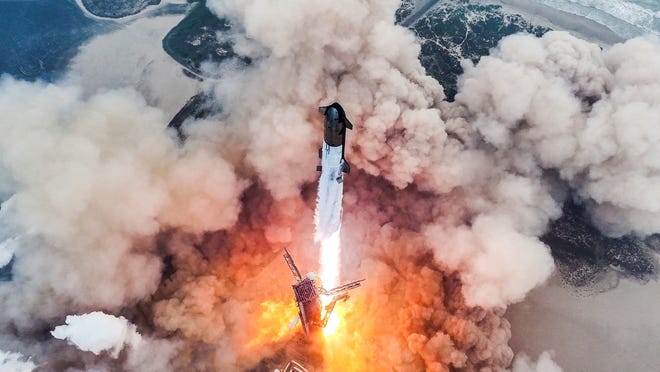SpaceX officials hope to soon launch and land massive 450-foot Starship-Super Heavy rockets up to 44 times a year at NASA’s Kennedy Space Center.
But Susan Palma, a 40-year-old Titusville resident, fears that further development at the Cape risks further disrupting the natural water flow and salinity of the endangered Indian River Lagoon. She attended an environmental meeting Wednesday on potential impacts from the spaceship, armed with a written statement warning of the dangers of hazardous materials and wildlife negatively affected by air, light and sound pollution.
“I moved to the river in 2011. And within three years, my waterfront went from brackish coastal waterfront to dead. It’s still dead. There’s no grass. There’s no plants. There’s no manatees anymore,” Palma said.
Cape Canaveral:Is there a launch today? Upcoming rocket launch schedule from SpaceX, NASA and ULA in Florida
“It’s dead. It’s brown. It stinks. It’s cloudy and dirty. And it’s been that way for ten years. I’m thinking about moving. If they expand the space center, and If they don’t pay attention to the consequences for the environment, I will probably move,” she said.
On Wednesday, the Radisson Resort in Cape Canaveral Harbor hosted a pair of open houses on the potential environmental impacts of Starship-Super Heavy. The Federal Aviation Administration is gathering comment on SpaceX’s plan to bring the mega-rocket system to pad 39A.
A collection of experts at the event answered one-on-one questions at eight poster-anchored stations in a conference room. The FAA is the lead agency in environmental impact assessment. Other participating federal agencies: NASA and the U.S. Air Force, the Coast Guard, the U.S. Fish and Wildlife Service, and the National Park Service.
On Thursday, the FAA will gather comments during a similar Starship-Super Heavy public meeting from 6 to 8 p.m. at the Debus Conference Facility at the Kennedy Space Center Visitor Complex.
A virtual meeting will then take place on Monday from 6:00 PM to 8:00 PM. More detail:
- Zoom URL: https://us06web.zoom.us/j/89402979916
- Zoom meeting ID: 894 0297 9916
- Optional dial-in numbers: 833-928-4608, 833-928-4609 or 833-928-4610.
The virtual meeting will consist of “an automatically executed presentation with closed captioning describing the purpose of the exploratory meetings, the project schedule, opportunities for public involvement, the summary of the proposed action and alternatives, and the summary of the environmental area” , the FAA reported.
In addition to the launch, SpaceX proposes to land Super Heavy boosters and Starships on pad 39A and on drone ships in the Atlantic Ocean; deploy super-heavy boosters in the Atlantic Ocean at least 5 nautical miles offshore; and place starships in the open ocean between 55 degrees south latitude and 55 degrees north latitude.
SpaceX officials want to build a Super Heavy containment tower on pad 39A, along with on-site facilities for propellant generation and storage, a cooling tower, an air separation unit and a flooding system, according to an FAA fact sheet.
A 2019 NASA environmental assessment of future Starship-Super Heavy operations found that the launches would not have a significant impact on the biological or physical environment on pad 39A.
SpaceX officials also hope to begin launching Starship-Super Heavy rockets at the Cape Canaveral Space Force Station by 2026. The Air Force, along with NASA, the FAA and the Coast Guard, is preparing an environmental impact statement for Starship.
Last week, crews loaded parts of a Starship launch tower onto a ship in the Turn Basin of NASA’s Kennedy Space Center for shipment to SpaceX Starbase in Brownsville, Texas.
Rockledge resident Brad Whitmore attended the open house Wednesday afternoon. He lives in a 105-year-old historic home just south of Cocoa Village — and he said rumbling vibrations from SpaceX Falcon 9 launches on southeastern trajectories over the past year may have caused cracks in his ceiling and wall. He said others are raising similar structural concerns in his immediate area, near the lagoon.
“(Launch frequency) will continue to increase dramatically in the future. And it will have the added benefit of adding from what are mainly Falcon 9s, more Falcon Heavys and large rockets like SLS, Starship and Blue Origin,” he said.
“The Falcon 9s can go from ‘you can barely hear them’ to ‘they’re shaking my house’ – and the windows of my house are shaking and rattling, and things on my desk are shaking and moving,” he said.
Visit floridatoday.com/space for the latest news from Cape Canaveral Space Force Station and NASA’s Kennedy Space Center.
Rick Neale is a space reporter at FLORIDA TODAY. Contact Neale atRneale@floridatoday.com. Twitter/X: @RickNeale1
Space is important to us, so we’re working to bring you top industry coverage and Florida launches. Journalism like this takes time and resources. Support it with a subscription here.

